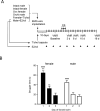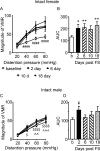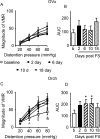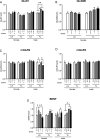Opposing Roles of Estradiol and Testosterone on Stress-Induced Visceral Hypersensitivity in Rats
- PMID: 29496640
- PMCID: PMC6026052
- DOI: 10.1016/j.jpain.2018.02.007
Opposing Roles of Estradiol and Testosterone on Stress-Induced Visceral Hypersensitivity in Rats
Abstract
Chronic stress produces maladaptive pain responses, manifested as alterations in pain processing and exacerbation of chronic pain conditions including irritable bowel syndrome. Female predominance, especially during reproductive years, strongly suggests a role of gonadal hormones. However, gonadal hormone modulation of stress-induced pain hypersensitivity is not well understood. In the present study, we tested the hypothesis that estradiol is pronociceptive and testosterone is antinociceptive in a model of stress-induced visceral hypersensitivity (SIVH) in rats by recording the visceromotor response to colorectal distention after a 3-day forced swim (FS) stress paradigm. FS induced visceral hypersensitivity that persisted at least 2 weeks in female, but only 2 days in male rats. Ovariectomy blocked and orchiectomy facilitated SIVH. Furthermore, estradiol injection in intact male rats increased SIVH and testosterone in intact female rats attenuated SIVH. Western blot analyses indicated estradiol increased excitatory glutamate ionotropic receptor NMDA type subunit 1 expression and decreased inhibitory metabotropic glutamate receptor 2 expression after FS in male thoracolumbar spinal cord. In addition, the presence of estradiol during stress increased spinal brain-derived neurotrophic factor (BDNF) expression independent of sex. In contrast, testosterone blocked the stress-induced increase in BDNF expression in female rats. These data suggest that estradiol facilitates and testosterone attenuates SIVH by modulating spinal excitatory and inhibitory glutamatergic receptor expression.
Perspective: SIVH is more robust in female rats. Estradiol facilitates whereas testosterone dampens the development of SIVH. This could partially explain the greater prevalence of certain chronic visceral pain conditions in women. An increase in spinal BDNF is concomitant with increased stress-induced pain. Pharmaceutical interventions targeting this molecule could provide promising alleviation of SIVH in women.
Keywords: Stress; estradiol; hyperalgesia; testosterone; visceral pain.
Copyright © 2018 The American Pain Society. Published by Elsevier Inc. All rights reserved.
Conflict of interest statement
Disclosures:
The authors have nothing to declare and have no conflicts of interest.
Figures






Similar articles
-
Estradiol modulates visceral hyperalgesia by increasing thoracolumbar spinal GluN2B subunit activity in female rats.Neurogastroenterol Motil. 2015 Jun;27(6):775-86. doi: 10.1111/nmo.12549. Epub 2015 Mar 24. Neurogastroenterol Motil. 2015. PMID: 25810326 Free PMC article.
-
Extracellular signal-regulated kinase activation in the spinal cord contributes to visceral hypersensitivity induced by craniofacial injury followed by stress.Neurogastroenterol Motil. 2018 Feb;30(2). doi: 10.1111/nmo.13161. Epub 2017 Jul 21. Neurogastroenterol Motil. 2018. PMID: 28730748
-
Chronic prenatal stress epigenetically modifies spinal cord BDNF expression to induce sex-specific visceral hypersensitivity in offspring.Neurogastroenterol Motil. 2014 May;26(5):715-30. doi: 10.1111/nmo.12326. Epub 2014 Mar 4. Neurogastroenterol Motil. 2014. PMID: 24588943 Free PMC article.
-
Transient receptor potential ion channel function in sensory transduction and cellular signaling cascades underlying visceral hypersensitivity.Am J Physiol Gastrointest Liver Physiol. 2017 Jun 1;312(6):G635-G648. doi: 10.1152/ajpgi.00401.2016. Epub 2017 Apr 6. Am J Physiol Gastrointest Liver Physiol. 2017. PMID: 28385695 Review.
-
Corticotrophin-releasing factor 1 activation in the central amygdale and visceral hyperalgesia.Neurogastroenterol Motil. 2015 Jan;27(1):1-6. doi: 10.1111/nmo.12495. Neurogastroenterol Motil. 2015. PMID: 25557223 Free PMC article. Review.
Cited by
-
Animal Models of Temporomandibular Disorder.J Pain Res. 2021 May 26;14:1415-1430. doi: 10.2147/JPR.S303536. eCollection 2021. J Pain Res. 2021. PMID: 34079358 Free PMC article. Review.
-
EXPRESS: Histone hyperacetylation modulates spinal type II metabotropic glutamate receptor alleviating stress-induced visceral hypersensitivity in female rats.Mol Pain. 2016 Jul 5;12:1744806916660722. doi: 10.1177/1744806916660722. Print 2016. Mol Pain. 2016. PMID: 27385724 Free PMC article.
-
The Role of Sex Hormones in Pain-Related Conditions.Int J Mol Sci. 2023 Jan 18;24(3):1866. doi: 10.3390/ijms24031866. Int J Mol Sci. 2023. PMID: 36768188 Free PMC article. Review.
-
Sex differences in visceral sensitivity and brain activity in a rat model of comorbid pain: a longitudinal study.Pain. 2024 Mar 1;165(3):698-706. doi: 10.1097/j.pain.0000000000003074. Epub 2023 Sep 27. Pain. 2024. PMID: 37756658 Free PMC article.
-
Sex-Bias in Irritable Bowel Syndrome: Linking Steroids to the Gut-Brain Axis.Front Endocrinol (Lausanne). 2021 May 19;12:684096. doi: 10.3389/fendo.2021.684096. eCollection 2021. Front Endocrinol (Lausanne). 2021. PMID: 34093447 Free PMC article. Review.
References
-
- Aloisi AM, Ceccarelli I, Fiorenzani P. Gonadectomy Affects Hormonal and Behavioral Responses to Repetitive Nociceptive Stimulation in Male Rats. Ann. N. Y. Acad. Sci. 2003;1007:232–7. 232–237. - PubMed
-
- Aloisi AM, Ceccarelli I, Fiorenzani P, De Padova AM, Massafra C. Testosterone affects formalin-induced responses differently in male and female rats. Neurosci Lett. 2004;361:262–264. - PubMed
Publication types
MeSH terms
Substances
Grants and funding
LinkOut - more resources
Full Text Sources
Other Literature Sources
Medical

